
Produced at Duy Khanh Mechanical Company, Ho Chi Minh City - Photo: QUANG DINH
According to Tuoi Tre , Vietnam Electricity Group (EVN) has just proposed to the Ministry of Industry and Trade to implement a two-component retail electricity price (including capacity price and electricity price), conducting a paper test for a group of large electricity customers with 200,000 kWh/month (calculated on average over the last 12 months), applied from October 2025.
That means, the current electricity price bill and the two-component electricity price will be issued in parallel before the official application, expected from the beginning of 2026.
Need to carefully assess the impact of electricity prices on businesses
Although the roadmap for application is about to be deployed by the Ministry of Industry and Trade, many manufacturing enterprises confirmed to Tuoi Tre that they have not yet received information about the two-component electricity price mechanism.
Even many businesses do not clearly understand what a two-component electricity price is, how to calculate and determine the electricity price, how to apply it, and the specific impacts on the business's electricity usage costs.
Mr. Do Phuoc Tong, Chairman of the Ho Chi Minh City Mechanical and Electrical Enterprises Association, was quite surprised when talking about the two-component electricity price and expressed that he did not understand what kind of price mechanism it was. Especially with the regulation on capacity price, he was quite concerned about the basis of application, method and basis for calculating the price.
Although his Duy Khanh Mechanical Company consumes less than 200,000 kWh of electricity per month and is not yet in the pilot phase, Mr. Tong is concerned that if this pricing plan is applied to all manufacturing enterprises, it could lead to additional costs in the context of enterprises facing many difficulties in the market and orders.
Similarly, Mr. Nguyen Van Hung, Director of Tam Hop Company Limited, said that the monthly electricity consumption is less than 200,000 kWh, but the cost price is a big burden for the business. Because the main raw material used for production is steel, which is the input item most affected when the electricity price increases, Mr. Hung is worried that every time the electricity price is adjusted, the steel price will increase, increasing the input cost.
According to Mr. Hung, businesses that sign contracts with customers must keep prices stable for a long time, some customers almost have to keep prices for several years. While electricity prices have been increasing continuously for the past few years, leading to many input costs such as labor and transportation costs, and orders are decreasing due to the impact of the trade war, businesses are just trying to hold on and maintain operations.
"Therefore, the application of pricing options that directly impact businesses needs to be carefully evaluated and more clearly informed so that businesses can understand and have business plans," Mr. Hung recommended, saying that businesses need time to research and evaluate the impact of new pricing options.
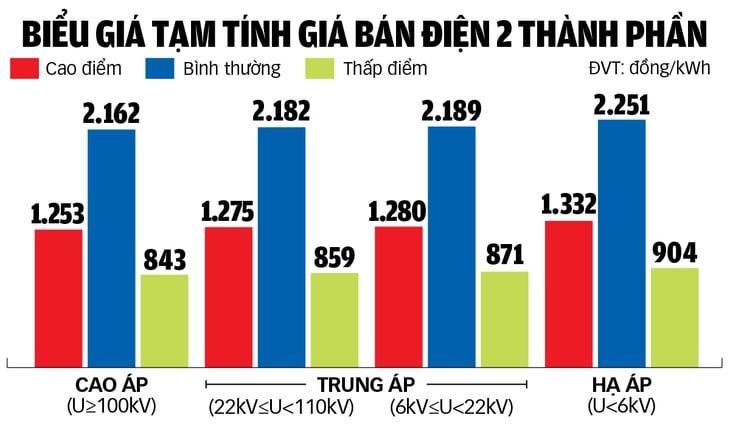
Graphics: TUAN ANH
What is the impact on pilot customers?
Assessing the impact of applying two-component electricity prices, the research unit said that each customer has different consumption characteristics, such as different maximum capacity (Pmax) and different output structure according to peak and off-peak hours, so electricity prices will be different.
Specifically, if two pilot units use the same Pmax (same capacity cost), but the 2-shift production unit and the 3-shift/day production unit have different maximum capacity usage time factors (Tmax), the capacity unit price calculated in kWh is different, then the high-low peak output structure is also different, meaning the average electricity unit price is also different.
On the contrary, if the consumption output is the same but the consumption time is different and the Pmax capacity is different, the average electricity price converted to kWh will also be different. This is the advantage of calculating the correct cost of the consumer household to the power system of the two-component electricity price list.
Based on the analysis of the consulting unit, EVN proposed that the Ministry of Industry and Trade give instructions to conduct a paper-based trial from October 2025, as well as the Ministry soon issue a decision on the roadmap for applying two-component retail electricity prices and documents guiding implementation.
The representative of the Electricity Department (Ministry of Industry and Trade) also said that according to its authority, the Ministry of Industry and Trade decides to apply the roadmap for implementing the two-component electricity price. From October 2025, it is expected to test printing invoices on paper, but businesses will not have to pay immediately according to the two-component price. It is expected that the official price will be applied from 2026. Currently, this roadmap is being put forward by the Ministry of Industry and Trade to seek opinions from all parties.
According to the consultant's recommendation, before officially applying to all production customers, there needs to be careful preparation in terms of measurement (both monthly maximum capacity components), legal framework, and communication work.
"In the initial period of application on paper (before official application), there needs to be close monitoring of implementation results, to make timely adjustments in all aspects, to ensure that the application of the official pilot phase is successful before expanding the subjects of application and completely replacing it," the representative of the consulting unit recommended.
Increase or decrease are within the range of 40 - 60%
According to EVN, the current retail electricity price list is still being implemented according to Decision 28 and there is no retail price list implemented according to Decision No. 14/2025 just issued by the Government .
The Ministry of Industry and Trade is drafting a circular to replace Circular 16 on the implementation of retail electricity prices, so the calculation unit has proposed four options for calculating electricity prices and different impact assessments. These include the option to apply according to the current electricity price structure, the option according to the price structure of Decision 14/2025, adjusting within the range of /-2%; reducing 2% at all levels and reducing 3% at all levels.
According to the general assessment of the consulting unit, the application of two-component pricing with the first two options has a positive impact when the electricity bill is reduced for more customers than the number of customers who receive a negative impact with increased bills if applying the base scenario or the reference scenarios. With the remaining two options, the number of customers with increased electricity bills is greater than the number of customers with reduced electricity bills.
However, the number of customers whose bills increase or decrease is within the range of 40 - 60% and there is not much difference, so the consulting agency believes that there will not be a one-way or uniform impact when applying the two-component electricity price in the case of households whose electricity bills increase or decrease.
According to the consulting unit, the increase or decrease depends entirely on the customer's electricity consumption characteristics.
Manufacturing enterprises have to pay extra for capacity.
According to the two-component electricity price plan being developed, the actual electricity price that businesses and users have to pay will include the capacity price and the electricity price. In which, the capacity price is determined based on the maximum capacity (Pmax) every month, and adjusted based on the CPI growth rate in 2023-2024 of 3.63% and the growth rate in 2025.
The electricity price component will be updated based on the current average retail electricity price of VND 2,204.0655/kWh applied from May 10; corresponding to the retail electricity price tables for different customer groups. EVN affirms that with the new price plan, it will maintain the principle of total electricity revenue of the two-component electricity price testing customer group unchanged.
This means that after determining the capacity component based on the fluctuation of the consumer price index (CPI), the electricity component is balanced according to the total revenue to ensure the revenue remains unchanged. Thus, along with the electricity price based on the actual electricity output calculated based on kWh during peak, off-peak and normal hours, the manufacturing enterprise will have to pay an additional capacity price.
This is defined as the fixed cost that customers cause to the electricity system, with the unit capacity price calculated in VND/kW/month.
According to the research project to develop a roadmap for applying two-component electricity prices calculated by the consulting unit for EVN, at the high voltage level (from 110kV), the peak hour price is 1,253 VND/kWh and the off-peak hour price is 843 VND/kWh; at the medium voltage level from 22kV to under 110kV, the peak hour price is 1,275 VND/kW and the off-peak hour price is 859 VND/kW; at the medium voltage level from 6kV to under 22kV, the peak hour price is 1,280 VND/kWh and the off-peak price is 871 VND/kWh; at the low voltage level below 6kV, the peak hour price is 1,332 VND/kWh and the off-peak price is 904 VND/kWh.
Source: https://tuoitre.vn/doanh-nghiep-lo-chi-phi-tang-them-voi-gia-dien-hai-thanh-phan-20251002232510357.htm


![[Photo] Students of Binh Minh Primary School enjoy the full moon festival, receiving the joys of childhood](https://vphoto.vietnam.vn/thumb/1200x675/vietnam/resource/IMAGE/2025/10/3/8cf8abef22fe4471be400a818912cb85)



![[Photo] Prime Minister Pham Minh Chinh chairs meeting to deploy overcoming consequences of storm No. 10](https://vphoto.vietnam.vn/thumb/1200x675/vietnam/resource/IMAGE/2025/10/3/544f420dcc844463898fcbef46247d16)





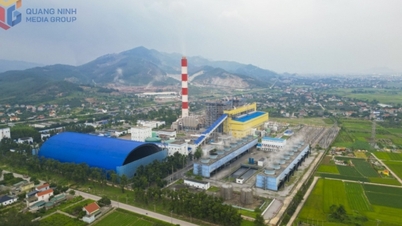



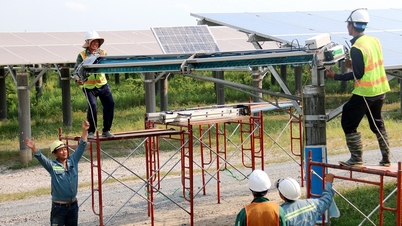
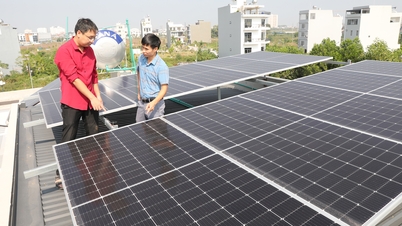







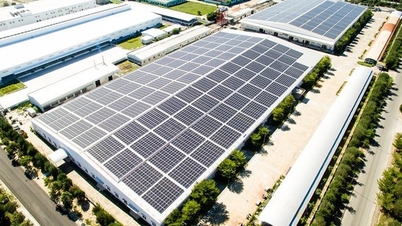








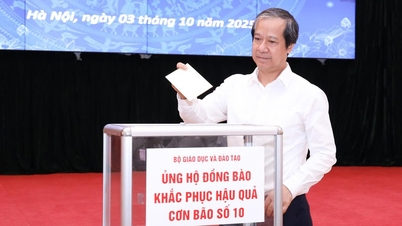






































































Comment (0)